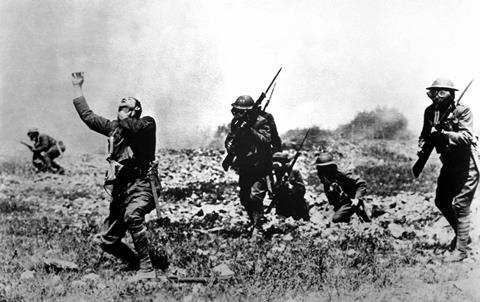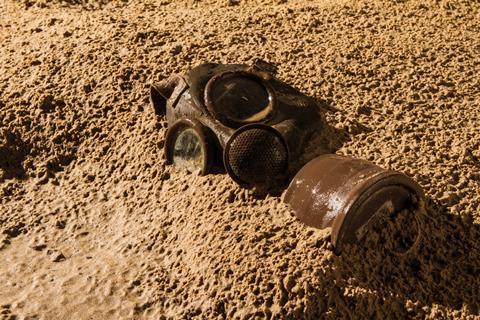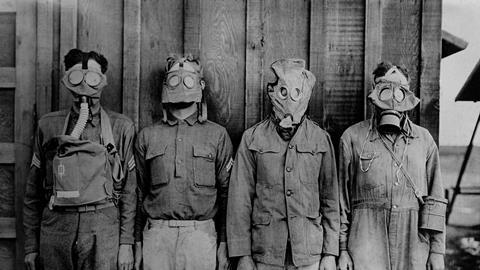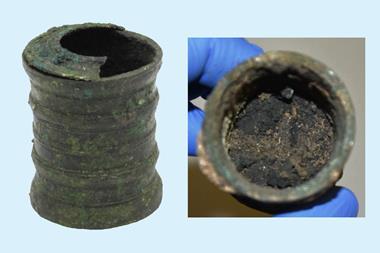Ben Valsler
This week, Michael Freemantle introduces a chemical weapon developed in the first world war that, luckily for the soldiers on the front line, never lived up to its terrible potential.
Michael Freemantle
You may not have heard of diphenylchlorarsine. It is one of the least well known of the sixty or so chemical warfare agents used in the first world war. These toxic war chemicals are generally known as poison gases. Diphenylchlorarsine, however, is not a gas at all. Under normal room temperature conditions, it exists as a white crystalline solid.

The Germans began firing artillery shells filled with the compound against the Russians on the Eastern Front in September 1917. They used it again on the Western Front in their Spring Offensive in 1918 against the Allies. The Germans called the chemical Clark I. ‘Clark’ is an acronym for the German name Chlor-Arsen-Kampfstoff, which means ‘chlorine, arsenic, warfare agent.’
Diphenylchlorarsine was a type of chemical warfare agent known as a sternutator. Also known as respiratory irritants, these were designed to attack the nasal passages of enemy troops and induce sneezing, vomiting and headaches. They also have an impact on the nervous system, produce giddiness and impairing the ability to walk. They were not lethal, however, at the concentrations encountered on the battlefield in world war I.
By the time of their introduction in September 1917, chemical warfare had been raging for two and a half years. Armies on both sides of the conflict had already employed a range of highly toxic gases. In the very first gas attack of the war, on 22 April 1915, the Germans killed some 5,000 Allied troops in a battle near Ypres in Belgium by firing clouds of chlorine at them. At the end of the year, the Germans began to use phosgene, another toxic gas, in further cloud gas operations against the Allies. These attacks added to the death toll.
So, you might ask, why did the Germans introduce a non-lethal chemical warfare agent in 1917 when lethal chemicals had already proved so fatally effective? The answer lies in the fairly sophisticated nature of the gas masks that the Allies had developed. The masks contained protective materials such as soda lime and charcoal that neutralised or absorbed the lethal gases. These materials do not remove diphenylchlorarsine, however.
Experiments had shown that the sternutator volatilises when heated to form a smoke that readily disperses in air. The smoke particles proved to be sufficiently small to penetrate and pass right through gas masks.

When an artillery shell filled with the sternutator exploded, the heat of explosion would, the Germans believed, create a cloud of these microscopic particles. Inhalation of the obnoxious microscopic particles would force the defending troops to wrench off their masks in order to sneeze or be sick. The troops would then be exposed to lethal gases that were being fired at the same time.
Chemical warfare that involves firing two types of artillery shell simultaneously is known as variegated shelling. The concept was introduced by the German chemist Fritz Haber who is considered to be the ‘father of modern chemical warfare’.
The use of diphenylchloroarsine in artillery shells proved a failure, however. The detonation and explosion of the shells did not provide sufficient time for the heat of explosion to be transmitted to the sternutator and volatilise it. The physical force of the explosion did produce smoke-like particles, but they were too large to penetrate gas masks.
The Germans attempted an improvement on Clark I with the introduction of a similar sternutator compound known as diphenylcyanarsine. They called it Clark II. The compound was the strongest of all the sternutators used in the war and, unlike Clark I, did not decompose in water. The molecules of both compounds consist of an arsenic atom bonded to two phenyl rings. The arsenic atom in Clark I is also attached to a chlorine atom, but in Clark II, the chlorine atom is replaced by a cyanide group.
After the war, Augustin Prentiss, a lieutenant colonel in the United States Army Chemical Warfare Service, wrote a book detailing the chemicals used in the war. He observed:
‘The failure to adopt a proper means of dispersing diphenylchlorarsine stands out as one of the few technical mistakes in chemical warfare that the Germans made during the world war.’
Furthermore, he points out, it was a costly mistake:
‘No less than 14 million artillery shells were loaded with this substance (and its analogue, diphenylcyanarsine) and great reliance was placed upon its supposed offensive-combat power in the German drives in the spring of 1918.’
The Allies subsequently provided conclusive evidence from their casualties lists during the offensive that the shells were largely ineffective.
Ben Valsler
That was Mike Freemantle on the fortunate failure of diphenylchlorarsine as a weapon of war. Next week, Brian Clegg brings us a compound that has been essential to the development of human civilisation.
Brian Clegg
A universal building material, a craft essential and a source of heat, all naturally supplied. Even today you’ll find it in most buildings. And at the heart of wood’s versatility is a complex aromatic polymer named lignin.
Ben Valsler
Find out more about the extremely useful compound growing all around us with Brian next week. Until then, get in touch with any compounds you would like covered – email chemistryworld@rsc.org or tweet @chemistryworld. I’m Ben Valsler, thanks for joining me.













No comments yet